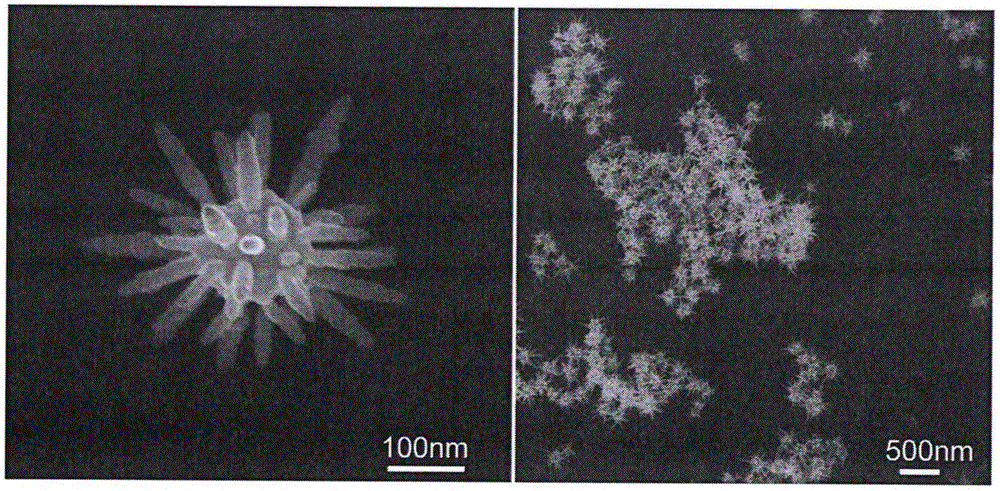Structure and preparation method for magnetic sliver-flower nano-particles
A magnetic nanoparticle and nanoparticle technology, applied in the field of nanomaterials and photonic materials, can solve the problems of unsatisfactory SERS performance, large surface roughness, large specific surface area, etc., and achieve convenient chemical modification, simple synthesis method, and good dispersion Effect
- Summary
- Abstract
- Description
- Claims
- Application Information
AI Technical Summary
Problems solved by technology
Method used
Image
Examples
Embodiment 1
[0031] A preparation of high-performance magnetic silver flower nanoparticles:
[0032] figure 1 A schematic diagram of the preparation process of magnetic silver flower nanoparticles is given. Its concrete preparation method is divided into the following five steps: the first step, adopts solvothermal synthesis method to synthesize the Fe of 100-600 nanometers 3 o 4 magnetic nanoparticles. Dissolve 1.35 g of ferric chloride hexahydrate in 40 ml of ethylene glycol, and stir magnetically for 30 minutes. Next, 2.7 g of sodium acetate and 1 g of polyethylene glycol 20000 were added to the solution and stirred until the reactants were completely dissolved, then the mixture was transferred to an autoclave (50 ml capacity) with a polytetrafluoroethylene liner and heated to 200 degrees Celsius reaction for 6-24 hours. The product was collected with a magnet, washed twice with deionized water and ethanol respectively, and finally the product was vacuum-dried at 60 degrees Celsius...
Embodiment 2
[0042] The SERS enhancement ability of magnetic silver flower nanoparticles was characterized by Raman labeling molecule p-aminothiophenol (PATP):
[0043] PATP is a commonly used sulfhydryl Raman marker, and it will produce significant chemically enhanced Raman characteristic peaks when combined with gold or silver. Configure different concentrations of PATP ethanol solutions (10 -5 -10 -12 mol), 1 ml per tube. Add magnetic silver flower nanoparticles to the above solution, and react with ultrasound for 30 minutes to fully combine PATP on the surface of magnetic silver flower nanoparticles. After magnetic separation, add the particle concentrate to a clean silicon chip, and perform Raman after drying. detection.
[0044] Figure 6 It is the experimental result of Example 2. Figure 6 Shown is the Raman map of PATP excited by magnetic silver flower nanoparticles, and the abscissa is the Raman shift, of which 1078, 1576cm -1 The peak is the main peak among the characteris...
Embodiment 3
[0046] Detection of Dithiocarbamate Pesticide Thiram Using Magnetic Silver Flower Nanoparticles:
[0047] Thiram is a commonly used dithiocarbamate pesticide with strong Raman characteristic peaks. The magnetic silver flower nanoparticles were added to different concentrations of thiram aqueous solution, incubated with ultrasound for 15 minutes, and the particles were magnetically enriched and directly detected by a portable Raman spectrometer.
[0048] Figure 7 It is the experimental result of embodiment 3. Figure 7 Shown is the Raman spectrum of the thiram bimolecule excited by the magnetic silver flower nanoparticles, and the abscissa is the Raman shift, of which 561, 1385cm -1 The peak is the main peak among the characteristic peaks of thiram bimolecules. Raman detection conditions are excitation time 5 seconds, excitation power 20%. The experimental results show that the detection limit of thiram by magnetic silver flower nanoparticles is 1×10 -10 Moore, with very ...
PUM
 Login to View More
Login to View More Abstract
Description
Claims
Application Information
 Login to View More
Login to View More - R&D
- Intellectual Property
- Life Sciences
- Materials
- Tech Scout
- Unparalleled Data Quality
- Higher Quality Content
- 60% Fewer Hallucinations
Browse by: Latest US Patents, China's latest patents, Technical Efficacy Thesaurus, Application Domain, Technology Topic, Popular Technical Reports.
© 2025 PatSnap. All rights reserved.Legal|Privacy policy|Modern Slavery Act Transparency Statement|Sitemap|About US| Contact US: help@patsnap.com



